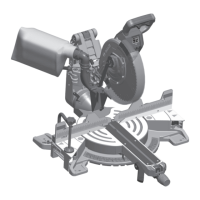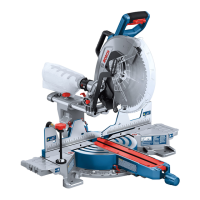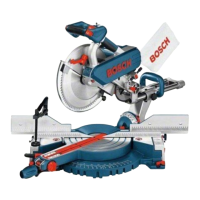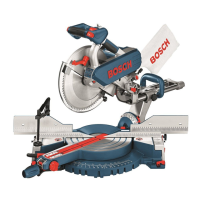57
Saw Operations
Crown Molding Auxiliary
Fence
When making a com-
pound cut on a molding
lying flat on the table, narrow cut-off
pieces (2" [50mm] or less in width) may
be propelled at high speed over the fence
and beyond the back of the tool (see Fig.
59). Use auxiliary fence as instructed and
shown in figures below.
An auxiliary fence is used to add support to
the cut-off workpiece such as large crown
molding when cut flat on the table (see Fig.
60). It will reduce splintering and move-
ment of the unsupported cut-off piece of
wood after the cut is made.
MAKING AN AUXILIARY FENCE:
Required pieces:
Wood Board (described below)
4 – Flat Head Machine Screws – 1/4" di-
ameter (M6); 2-1/2" (65mm) long
4 – 1/4" (M6) Flat Washers
4 – Nuts
1. Cut a nominal 1" x 2" wood board to a
length of 26-1/16" (662mm) long. NOTE:
1" x 2" nominal equals 3/4" x 1-1/2"
(19x38mm) actual. 3/4" (19mm) ply-
wood cut to size may be substituted.
2. Drill four holes through the board using
a 5/16" (8mm) diameter drill bit. Coun-
tersink the holes deep enough so that
the flat head screws will rest below the
front work surface – use a 1/2" (13mm)
diameter drill bit (see Fig. 61).
Remove the sliding fences from the tool –
see page 38.
1. Place the flat head screws through the
holes in the auxiliary fence, then the
holes in the stationary fence on the tool.
2. Place the washers and nuts over the
screw threads and against the stationary
fence. Tighten nuts.
FIRST-TIME USE OF THE AUXILIARY
FENCE:
NOTE: The first time the auxiliary fence is
used, it will be cut through by the saw
blade – cutting through creates minimal
clearance which reduces splintering on the
workpiece. Set the miter angle and the
bevel angle required before making the first
cut.
Be aware of the path of
the saw blade. Make a
dry run with the saw Off by conducting a
simulated cutting cycle, and observe the
projected path of the saw blade. Keep
hands at least six (6) inches (152mm)
away from the projected path of the saw
blade.
Clamp the workpiece, then make cut – ex-
ample: compound cutting large crown
molding flat on the table (see Fig. 58).

